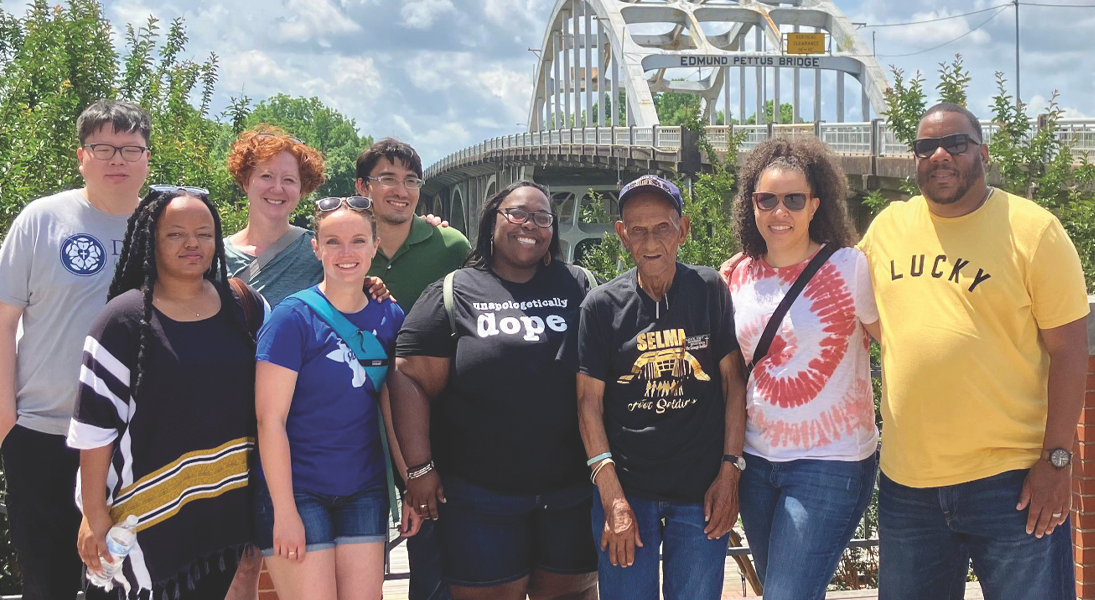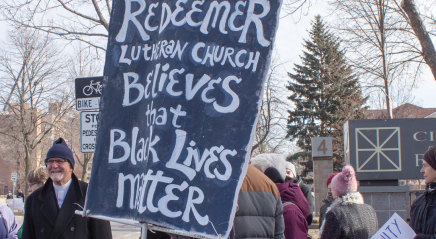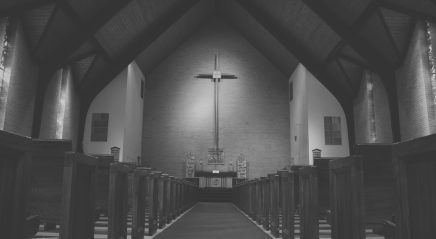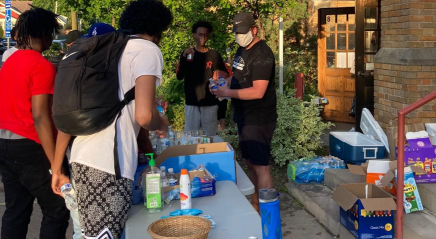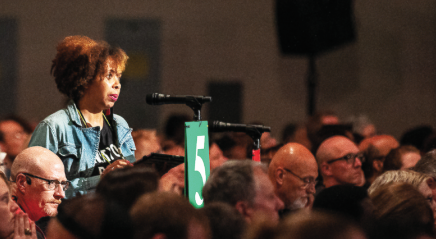It’s often called the National Lynching Memorial. Located at the Legacy Museum in Montgomery, Ala., the National Memorial for Peace and Justice consists of 805 hanging steel rectangles that represent each U.S. county where a lynching has taken place.
One day in May, after two years of study and deep discussion about the role of reconciliation in the church, Lutherans from Duke University in Durham, N.C., stood at the memorial and reflected on its enormity with members of St. Joseph African Methodist Episcopal (AME) Church, Durham.
The visit was one stop on a trip led by Amanda Highben—pastor of Duke Lutherans, the school’s Lutheran campus ministry—as part of a racial reconciliation partnership program between white Duke students and young adults of African descent from St. Joseph. The program funded by a grant from the North Carolina Synod.
This year program members read Called to Reconciliation: How the Church Can Model Justice, Diversity, and Inclusion (Baker Academic, 2022) by Jonathan C. Augustine, pastor of St. Joseph. Tim Smith, bishop of the North Carolina Synod, led a synodwide study of Augustine’s book.
“It’s hard to put this into words,” Highben said of the visit. “These victims—for so long their names were unknown. We walked through and tried to witness it. Everyone was deeply trying to absorb it, even more so for our friends of color who were on that trip with us. Of course, they were experiencing it in a way that was different from us who are white, and in a way that we couldn’t necessarily understand.”
Highben said she understood that, though the group could share the moment, the history of racism in the United States meant not all members would be impacted in the same way by this or other key sites. That was a major reason the reconciliation partnership was conceived: to provide a safe space for reflection and action based on awareness of racism and violence against people of African descent.
It’s up to us
The partnership grew from a 2020 effort by synod congregations (including St. Paul Lutheran in Durham) to plan a joint service with AME congregations to commemorate the deaths of the Emanuel Nine—members of Mother Emanuel AME Church in Charleston, S.C., who were murdered during a 2015 Bible study by a white supremacist raised in an ELCA congregation.
Ultimately, the service had to be canceled because of COVID-19. But Highben and Augustine had connected about how to collaborate.
“He was so gracious and excited, and at that point, I still didn’t know what this would look like,” Highben said of Augustine and their potential partnership. “But I asked if there was a way where our young adults and students could partner with their students at St. Joseph. And from there, we started to flesh things out, what it might look like given the limitations because of COVID.”
In the program’s first year—over the 2020-21 academic year—students studied Roadmap to Reconciliation: Moving Communities Into Unity, Wholeness and Justice (IVP, 2015) by Brenda Salter McNeil, based on Augustine’s recommendation. “It had theological depth,” Highben said, “but it had a lot of practical applications for people really wanting to do this work in their congregations and do it ecumenically as well.” About 20 people joined to study the McNeil book and build friendships over Zoom.
Student leaders received scholarships paid for by the grant. “We wanted two students from St. Joseph and two Duke Lutherans to serve as leaders and facilitators for the group, because in campus ministry it’s so important for things to be student-led and for the students to have ownership,” Highben said. “And they had so much energy and passion, and had been doing this work already and cared deeply about these issues.”
In spring 2021, the commemoration service for the Emanuel Nine that had been canceled the previous year was held at St. Joseph. Program members helped plan and participated in the service.
“They had so much energy and passion.”
Highben knew she wanted the partnership to continue beyond that service. She received grant money from the synod for a second year, which coincided with the release of Augustine’s book.
Smith endorsed Called to Reconciliation upon its publication. “It was one of the most revealing and encouraging books on racial reconciliation I have read,” he said, “and I probably read eight during the pandemic, because it’s just been so much on our hearts and minds over the last couple of years.”
Smith led the study over Zoom, and Augustine participated in the first and last sessions.
“We did it with a panel,” Smith said. “It was usually some white people and some Black people on every panel. We had people speaking from different perspectives, including a seminary president and some members of our [synod] Racial Justice Network. It was more of a conversation, and there were maybe another 80 to 100 people who were not participating in the discussion who could type questions in the chat bar.”
One of the synod’s four core values is reconciliation. “It’s really kind of the meaning of life,” Smith said. “It’s what heaven has to be if there is a heaven, to be the perfect reconciliation of all relationships. And it’s [up to] us to be intentional about this work.”
In Called to Reconciliation, Augustine argues that the reconciliation practiced in the church can serve as a model for the rest of society, but that the church needs to be proactive as well as reactive.
“I wanted to make a contribution to the church and to the academy that would be sustaining and would … have an impact that I think would be lasting,” Augustine said of the book. “Reconciliation is a subject matter that is not going anywhere, given the long-term enmity that has existed because of racial lines.”
A good start
On their four-day trip this year, Highben and 10 others from the group also visited the Edmund Pettus Bridge in Selma, Ala. In 1965 many civil rights movement demonstrators, including the late Congressman John Lewis, were beaten by police on the bridge during voter rights protest marches led by Martin Luther King Jr.
Highben and the group were guided on the bridge by George Sallie, who marched across the bridge in 1965, and Terry Chestnut, the son of J.L. Chestnut Jr., the first African American lawyer in Selma, who served as an attorney for King. The trip also included a visit to the historic Ebenezer Baptist Church in Atlanta.
Highben knows many congregations may not be able to develop as extensive a racial justice partnership as her group has. But she said a good start toward reconciliation can be to make a connection by attending another congregation’s worship services, which has happened with St. Paul Lutheran and St. Joseph AME.
“That’s worked really well for us,” she said. “We know that Sunday morning is the most segregated hour in the week. This is one practical way to overcome that.”
For resources on racial justice, visit elca.org/racialjustice.



